Combat Vehicle 90
The Combat Vehicle 90 (CV90; Sw. Stridsfordon 90, Strf90) is a family of Swedish tracked combat vehicles designed by Sweden's Defense Materiel Administration (Försvarets Materielverk, FMV), Hägglunds and Bofors during the mid-1980s and early 1990s and entered service in Sweden in the mid-90s. The CV90 platform design has continuously evolved in steps from Mk0 to current MkIV with advances in technology and in response to changing battlefield requirements. The Swedish version of the main infantry fighting vehicle is fitted with a turret from Bofors that is equipped with a 40 mm Bofors autocannon. Export versions are fitted with Hägglunds E-series turrets, armed with either a 30 mm or a 35 mm Bushmaster autocannon.[1]
| Combat Vehicle 90 | |
|---|---|
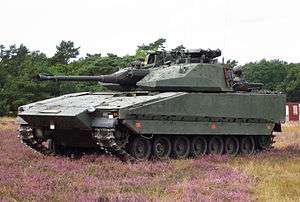 A Strf9040C in Swedish service | |
| Type | Infantry fighting vehicle |
| Place of origin | Sweden |
| Service history | |
| In service | 1993–present |
| Used by | See Operators |
| Wars | War in Afghanistan United Nations Mission in Liberia |
| Production history | |
| Designer | Hägglunds/Bofors |
| Manufacturer | BAE Systems AB |
| Produced | 1993–present |
| No. built | c. 1,200 |
| Specifications | |
| Mass | 23–35 tonnes (Mk0 to MkIII) |
| Length | 6.55 m (21.5 ft) |
| Width | 3.1 m (10 ft) |
| Height | 2.7 m (8 ft 10 in) |
| Crew | 3 (commander, gunner, driver) 8 troopers |
Main armament | 40mm Bofors L/70 autocannon, 35mm/50 Bushmaster autocannon (export models MkIII and MKIV) 30mm Bushmaster autocannon (export model MkI & MkII) |
Secondary armament | 7.62 mm Ksp m/39 machine gun 6 × 76 mm grenade launchers |
| Engine | Scania DS14 14 litres diesel I6 or DC16 16 litres diesel V8 engine 550–810 hp (410–595 kW) 2,300 Nm |
| Power/weight | 17.65 kW/t (24.1 hp/t) |
| Transmission | Automatic |
| Suspension | torsion bar |
Operational range | 320 km (200 mi) |
| Maximum speed | 70 km/h (43 mph) |
Developed specifically for the Nordic sub-arctic climate, the vehicle has very good mobility in snow and wetlands while carrying and supporting six to eight fully equipped dismount soldiers. Other variants include Forward Observation, Command and control, anti-aircraft, armoured recovery vehicle, electronic warfare and so forth. The CV90 and Hägglunds E-series turrets have been under continuous development with more than 4 million hours invested and are still produced with modern protection, armament and network enabled solutions. Currently, 1,280 vehicles in 15 variants are in service with seven user nations, four of which are NATO members, under BAE Systems Hägglunds AB.[2][1]
History
During the Cold War, in 1983, the Swedish Army required vehicles with high mobility, air defence and anti-tank capability, high survivability and protection. The "Stridsfordon 90" project group was formed by representatives from the Swedish armed forces (Försvarsmakten), the FMV and Swedish industry, including Hägglunds and Bofors, which in 1985 finalized the design for a "unity-vehicle" that originated from an air force concept. In 1986, the prototypes for Strf 9040 and Strf 9025 were ordered. Five prototypes were constructed but, before delivery in 1988, the 9025-version was discontinued. These prototypes were tested during extensive trials for three years between 1988 and 1991, during which the prototypes for specialized variants (FOV, C&C and ARV) were ordered.[3] The first deliveries started in 1994.
The CV90 has undergone four mark shifts to meet different customer requirements, focused on capability enhancements.
CV90 Mk 0
The first delivered CV90 was for Sweden. It was armed with the Bofors 40/L70 cannon in a 2-man turret. The vehicle had a conventional electrical system and was fitted for but not with appliqué armour systems. The Swedish Army ordered five variants of the CV90. The requirements expressed by the Swedish FMV on signature management were extremely challenging and led to a lot of new design features that have been inherited by all subsequent generations (Mk 0-III). FMV also prioritized the requirements to provide the best possible design to fulfil user needs. Furthermore, the CV90 was also built for high reliability and ease-of-maintenance using only standard on-board tools and conscripts to maintain and operate.
CV90 Mk I
The next variant of CV90 is known as the Mk I and was delivered to Norway. CV90 Mk I won the Norwegian competition for a new IFV against other contemporary IFVs, such as Bradley, Warrior and Pizarro/ULAN. The Mk I variant of the CV90 had a newly designed 2-man 30 mm turret evolved from the 25 mm turret. CV90 Mk I was the first IFV with a high hit probability performance during suppression fire modes, both while the vehicle is on the move and against air targets. The CV90 Mk I incorporated several improvements compared to the original Swedish CV90. Trials on mobility, reliability, lethality, fightability, ergonomics, durability and survivability were performed during the trials phase for these vehicles with good results for CV90 Mk I.
CV90 Mk II
The CV90 Mk I was the base for the next development step, CV90 Mk II. The CV90 Mk II was produced in three variants, CV9030 CH (Switzerland) IFV & COM, and CV9030 FIN (Finland) IFV. Both contracts were won in competition with other IFVs. The difference between the two variants is mainly the size of the hull. The Swiss variant is 100 mm higher over the front part of the hull and an additional 70 mm over the combat compartment at the rear. The principal difference between the Mk I and Mk II is that the Mk II was partly digitized and provided with built-in Health & Unit Monitoring System (HUMS) together with interactive manuals and instructions. CV90 Mk II standard armament is Mk44 Bushmaster II autocannon.
CV90 Mk III
The Mk III variant of the CV90 is a further development of the CV90 Mk II. The areas that have undergone most development compared to Mk II are lethality, fightability, electronic architecture, survivability and mobility. The weapon system has been upgraded to a 35/50 mm Bushmaster III cannon with an integrated muzzle ammunition programmer and a number of different firing scenarios depending on target setup. The crew station design provides the gunner and commander with a continuous eye-on-target engagement feature (do not need to remove head from eye-piece to see and operate equipment).
The electronic architecture has been further upgraded for Mk III to be completely digitized. The mobility improvements, in the field of upgraded suspension and power to weight ratio, was performed to handle the increased gross vehicle weight. The improved survivability was mainly in the areas of mine protection and top attack. The horizontal protection has been designed in similar ways as to the other marks of CV90, i.e. appliqué systems. The first variant of the Mk III, the Mk III a, was delivered to The Netherlands and Denmark. The second, most modern Mk IIIb variant, was delivered to Norway.
CV90 Mk IV
CV90 MkIV is equipped with a new engine, active protection system, augmented reality system iFighting and its weight has increased from 35 to 37 tons, with space for two tons of additional payload.[4][5][6]
Design
Various customer requirements have led to several variants of the CV90, where major differences are in survivability and electronic architecture. Higher protection has led to higher kerb weight; the vehicle's combat weight has risen from 23 to 35 tonnes. With increasingly more powerful diesel engines, the power-to-weight ratio has remained approximately the same. The track suspension system has seen upgrades in several stages.
The Mk III version has a digital electronic architecture with several different CAN-buses and digital networks, and is the first IFV incorporating an automatic Defensive Aid Suite which classifies threats and, in automatic mode, can fire smoke and/or the main gun to eliminate or evade targets, as well as instruct the driver on potential threats. At the Eurosatory 2010 exhibition, a version called Armadillo[7] was presented. The Armadillo shown was an Armoured Personnel Carrier (APC) version. The basic chassis can be readily converted to ambulance, control vehicle or other turreted versions.
Protection
The CV9040's basic armour provides all-round protection against 14.5 mm armour-piercing rounds. Armour protection over the frontal arc is classified, but all models from CV9040B and later are said to be protected against 30 mm APFSDS. Some variants, including the CV9030N, can be fitted with MEXAS, a ceramic appliqué armor that provides protection against 30 mm APFSDS. This armour kit is intended to provide increased protection against Improvised explosive device, explosively formed penetrator and 30 mm caliber armour piercing rounds.[8] All CV90s are fitted with a Spall liner, which covers the interior spaces and provides protection for the troops inside against shrapnel and anti-personnel artillery munitions.
The CV90 can be also fitted with cage armour, which provides protection against tandem-charge and shaped charge warheads. The CV90 is fitted with a nuclear, biological, and chemical (NBC) filtration system accompanied by a chemical detector and radiation detector systems. The CV90 also uses heat-absorbing filters to provide temporary protection against thermal imaging (TIS), image intensifier and infrared camera (IR). The CV 90 was designed to produce a very low and very compact structure to minimize radar and IR-signatures.
With every generation of CV90 there has been an increase in payload and corresponding protection levels. The inherent mine protection levels have risen substantially to presently defeat the heaviest (10 kg TNT) anti-tank mines.[7]
In December 2016, BAE Systems received a contract from the Netherlands to test the Israel Military Industries (IMI) Iron Fist active protection system on their CV9035 vehicles. Iron Fist employs a multi-sensor early warning system using both infrared and radar sensors to deploy soft- and hard-kill countermeasures against anti-tank rockets and missiles. A decision for integration is to be made by early 2018.[9]
Mobility
The CV90 Mk0 is powered by a DSI14 engine developed by Scania, which provides 550 horse power (HP) and it can reach speeds of 70 kilometres (43 mi) per hour. The basic CV90 has a maximum road range of 320 kilometres (200 mi), but the latest generation can reach up to 600 kilometres (370 mi).[10][11] The CV90 offers quieter movement for improved stealth, greater speed over good terrain, and higher ground clearance for protection against mines and improvised explosive devices.
BAE Systems is considering upgrading the CV90 with a hybrid-electric propulsion system as armies look to cut fuel expenses, due to environmental issues and fuel economy. A hybrid-electric drive could cut fuel consumption by 10 to 30 percent. The new system would also provide a power boost to move the vehicle. The hybrid-electric combines a standard diesel engine with a battery pack to provide extra power to propel the vehicle or provide additional electricity.[12] BAE Systems Hägglunds uses the knowledge acquired through many years of hybrid-electric drive development for the military SEP vehicles and the ongoing civilian hybrid-electric projects for forest machines, airplane howlers and loaders.
In April 2015, BAE Systems fitted a CV90 with an active damping suspension system derived from Formula One racing cars. This technology calculates the vehicle's speed and anticipates the terrain ahead, then pressurizes the suspension at independent points to lift the chassis and keep the vehicle level. The suspension, which had been modified to suit a 38-ton armored vehicle rather than the 700 kg (1,500 lb) racing car, reportedly increases speed by 30-40 percent on rough terrain, outrunning main battle tanks, decreases vehicle pitch acceleration by 40 percent, gives greater maneuverability and stability for on-the-move gunnery, and reduces crew fatigue and life-cycle costs.[13]
Armament
The basic CV90 is fitted with a two-man turret armed with a 40 mm Bofors autocannon and a coaxial 7.62 mm machine gun. The CV90 also carries six 76-mm grenade launchers, which are arranged in two clusters of three launchers; the clusters are positioned on each side of the turret. The grenade launchers are intended for smoke grenades, but can also be loaded with a variety of combat grenades.
The CV90 export variants are fitted with a Hagglunds E-series turret, with more than 600 E30 and E35 turrets delivered. BAE Systems Australia Limited presented an offer for LAND 400 Phase 3 is the CV9035 with an E35 turret. It provides high commonality with BAE Systems’ LAND 400 Phase 2 CRV offer – the AMV35 – through its use of the same E35 turret system.
Sight
The CV90 is equipped with a UTAAS (Universal Tank and Anti-Aircraft Sight) from Saab. Daytime optical, thermal imaging System (TIS) and Generation III image intensification. The Norwegian IFV, C2, Recce, Mortar and Combat Engineer variants are delivered with the Kongsberg Protector Remote Weapon Station with 360 degrees day and night sights as well as hunter killer capability.
Production
Production of the CV 90 began in 1993, and as of 2014 over 1,200 vehicles had been ordered.[14] In November 2000, Finland ordered 57 CV9030 vehicles.[15] Total cost was €250 million (2008 value), or €4.42 million per vehicle.[16] In June 2004, Finland made another purchase, bringing the overall quantity ordered to 102.[17] This time, the cost was €2.92 million (2008 value) per vehicle.[17] In December 2005, Denmark ordered 45 CV9035 vehicles for a cost of €188 million or €4.18 million per vehicle.[18]
The Netherlands ordered 184 combat plus 8 instruction CV9035 vehicles for a cost of €749 million, or €3.9 million per vehicle. Norway initially bought 104 CV90s in the 1990s, buying new vehicles and upgrading the old ones in the 2010s. The Norwegian Army fields 144 CV90s, of which 74 are combat vehicles, 16 engineering vehicles, 16 multi-use vehicles, 21 reconnaissance vehicles, 15 command vehicles, and two instruction vehicles. The upgrade of the Norwegian CV90s was estimated to cost around 10 billion kr.[14]
Research
In 2011, Hägglunds (now BAE Systems AB) demonstrated a version with an infrared camouflage called Adaptiv, consisting of thermoelectric plates capable of posing as many different objects, such as ordinary cars, stones, trees etc. to an enemy IR-viewfinder. It takes 1,500 plates to cover a CV90, at a cost of $100 per plate.[19]
Variants
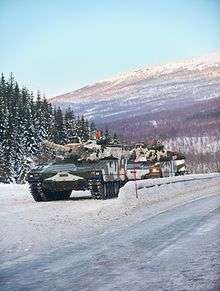
Domestic
Developed by Hägglund/Bofors in cooperation with FOA and FMV for Försvarsmakten as part of the Stridsfordon 90 (Strf 90)-family.[20] Sweden originally planned for a mix of CV9040 and CV9025, tests of the 25 mm turret being carried out on an Ikv 91 chassis, but finally decided on the 40 mm version, due to the much higher versatility of the larger calibre.[21]
- Stridsfordon (Strf) 9040 (SB1A3): The original model carries eight soldiers and is equipped with a 40 mm Bofors autocannon. From November 1997, the gun was gyro-stabilized.[20]
Versions are referred to by the letters A, B or C depending on upgrades. All from A onwards remain in service.
- Strf 9040 : Original production version with no gun stabilization and Lyran mortar. Incremental improvements during production, all have been upgraded to Strf9040A standard.
- Strf 9040A: Strf 9040 upgraded with extensive chassis modifications and external gun stabilisation on turret front. More storage and better emergency exits reduced the seats to seven in the troop compartment.
- Strf 9040B: 9040A updated with improvements to armament (new fire control software, electric firing pin, fully stabilized gun with internal stabilisation and reserve sight with video camera for the gunner), improved suspension for better accuracy and crew comfort while moving, new instrumentation and new seatbelts.
- Strf 9040B1: Strf9040B modified for international peacekeeping missions, has a 3P ammunition programmer, climate control and Anti-Spall Liner.[22]
- Strf 9040C: Up-graded version for crew training and international operations. As per 9040B1 with additional all-round armour, laser filtering in all periscopes and tropical grade air conditioning. Due to the bulk and weight of the modifications, only six soldiers can be carried.[20]
- Luftvärnskanonvagn (lvkv) 9040: Anti-Air Vehicle, fitted with PS-95 radar from Thomson CSF Harfang (now Thales Group) and a high elevation 40 mm autocannon capable of using programmable ammunition. It is connected to the national air defence net LuLIS. Three have been upgraded to C-standard.[23] There is also a demonstrator, designated Lvkv 90-TD, fitted with infrared video targeting and a fully stabilized gun for firing on the move.[24]
- Granatkastarpansarbandvagn (Grkpbv) 90120:, (Tracked armoured mortar vehicle): A CV 90 fitted with two 120 mm mortars. The 40 CV90 hulls for this project had already been purchased by 2003 and were originally intended to be equipped with the Patria Advanced Mortar System. For economic reasons, the Patria order was cancelled and the vehicles put in storage until BAE Systems AB received a contract in December 2016 to install Mjölner 120 mm mortars on the 40 CV90s to increase the indirect fire capability of mechanized battalions.[25] The first units were scheduled to be delivered in January 2019 and all 40 vehicles will be delivered by 2020.[20]
The command, forward observation and recovery vehicles are armed only with a machine gun.
- Stridsledningspansarbandvagn (Stripbv) 90, (Forward Command Vehicle): Used by battalion and brigade commander for command & control. Two were upgraded to C-standard, but have been decommissioned as of 2011.[23]
- Eldledningspansarbandvagn (Epbv) 90, (Forward Observation Vehicle): For directing artillery and mortar fire, more advanced IR sensor fitted; eight have been upgraded to C-standard.[23]
- Bärgningsbandvagn (Bgbv) 90, (Armored Recovery Vehicle). Two 9-tonne winches provides a maximum capacity of 72 tonnes through 4-way pulleys. Three have been upgraded to C-standard.[23] and at least one has been used in Afghanistan.
The following versions were not taken into Swedish army service.
- Störpansarbandvagn (Störpbv) 90, (Electronic Warfare Vehicle): A 9040A had its turret replaced with a fixed housing containing retractable mast and a LEMUR weapons station. Planned in 2002, a single unit was produced before serial production was cancelled for economic reasons and as of 2013 the project is still on hold.[20]
- Stridsfordon 9040/56: Prototype version of the CV 9040 equipped with the Bofors RB56 anti-tank missile. Issues with the sight alignment were unsolved and no units ordered.[20]
Export versions
The export versions of CV90 is delivered with the combat proven BAE Systems Hägglunds E-series turrets with armament ranging from 30-120mm. The vast majority of the 600 turrets delivered are fitted with 30mm or 35mm guns.
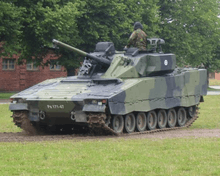
- CV9030
- Export version with a 30 mm Bushmaster II autocannon. Adopted by Norway, Switzerland and Finland. Within BAE Systems Hägglunds, the original version of the Norwegian CV9030N is known as the CV90 MK I. The Finnish CV9030FIN and Swiss CV9030CH vehicles are known as the CV90 MK II.[26] The CV90 MK II is also available as CV9030 COM – Command & Control Vehicle. The recently upgraded CV9030N infantry fighting, command & control and reconnaissance vehicles for Norway are known as CV90 MkIIIb, and this is the most advanced variant currently in service.[27]
- CV9035
- Armed with a Bushmaster III 35/50 cannon. Adopted by the Netherlands as CV9035NL and Denmark as CV9035DK. Within BAE Systems Hägglunds, CV9035 is known as the CV90 MK III.[26]
- CV90105
- Light tank equipped with 105 mm rifled tank gun/turret. Designed by Hägglunds (BAE Systems) and GIAT (Nexter). A newer version features the Cockerill XC-8 turret.[28]
- CV90120-T
- Light tank equipped with a tank turret equipped with a smoothbore 120 mm gun. (RUAG 120 mm Compact Tank Gun)
- CV90 CZ
- Export variant designed in collaboration with VOP CZ marketed to the Czech Republic, manned turret variant.[29]
- CV90 CZr
- Export variant designed in collaboration with VOP CZ marketed to the Czech Republic featuring a Kongsberg MCT-30 unmanned, remote controlled turret, a slightly raised hull and periscope system.[29][30]
- Armadillo
- Armoured personnel carrier version built on a modular CV90 Mk III chassis. The CV90 Armadillo can be modified to become a personnel carrier, an ambulance, a command and control centre, a recovery vehicle and many other non-turreted variants at low cost due up to 80% commonality among variants.[31] Currently, only the APC version has been built, with five delivered to Denmark for trials.[32]
- CV90 STING
- Combat engineering variant built on CV90 Mk I chassis. This vehicle can be outfitted with either a mine plow or a mine roller, and it also has a robotic arm. 16 have been ordered by the Norwegian Army.[33]
- CV90RWS Multi BK
- Mortar carrier variant built on a CV90 Mk I chassis. This vehicle is armed with a VingPos Mortar Weapon System outfitted with an 81mm L16A2 mortar. 16 have been ordered by the Norwegian Army.[34]
- CV90 MkIV
- BAE-developed upgraded variant revealed in January 2018, marketed to the Czech Republic as well as existing customers as an upgrade package. Features include a Scania engine with up to 1000 horsepower, X300 transmission, and an increased payload of 2 tonnes. The system also includes BAE's iFighting computer system, which claims to enhance situational awarenss, aid decision making, improve ergonomics, and enable autonomous support and remote operation.[35][36]
Combat service
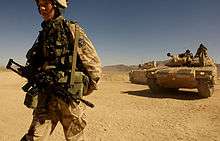
First use was by the Swedish UN forces in Liberia 2004, where 13 Stridsfordon 9040C were deployed.[20]
Since production began in 1993, the CV90 had remained untested in combat until November 2007, when Norwegian Army CV90s from the 2nd Battalion saw heavy combat during Operation Harekate Yolo in Afghanistan. During the first week of November, Norwegian ISAF forces from the 2nd Battalion and Kystjegerkommandoen based in Mazar-e-Sharif, responded to a Taliban attack on Afghan National Army forces in the Ghowrmach district. Having been heavily outnumbered by the Taliban forces, the Norwegians used mortars and, in particular, CV90s, to suppress the attack. The operation left an unknown number of Taliban casualties, but Norwegian news sources say as many as 45 to 65 Taliban fighters may have been killed, and many more wounded.[37]
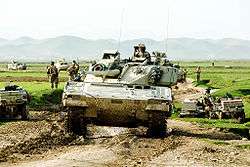
The CV90 was later used extensively by ISAF forces of the Norwegian Army's Telemark Battalion in May 2008, when the battalion came under heavy machine gun and RPG fire from Taliban fighters during Operation Karez in Badghis Province. The attack left 13 Taliban fighters dead and an unknown number wounded. No allied casualties were reported.[38] In January 2010, a Norwegian soldier was killed when a CV9030 hit a large IED in Ghowrmach, Afghanistan.[39]
In February 2010, Denmark sent ten CV9035DKs to Afghanistan in order to bolster their contingent in Helmand Province. The Danish contingent had suffered numerous casualties since they began operations in the province in the autumn of 2006. The vehicles are from the Danish Royal Lifeguard Regiment, based in the Northern part of Seeland. They are working alongside MOWAG Piranha IIIC, MOWAG Eagle IV, M113 G3DK and Leopard 2A5DK vehicles, all contributed by Denmark, in the Helmand Province. By April 2010, two of the ten vehicles had been hit with IEDs, in both cases protecting the crew and passengers from personal injury.[40] The vehicles lost two wheels and tracks, and were sent back to the manufacturer in Sweden for further investigation. On 7 August 2010, a CV9035DK hit an IED in Afghanistan, killing two soldiers and wounding another three. The explosion was so powerful that the vehicle was turned over.[41]
As of the spring of 2011, Sweden operates nine Strf 9040Cs in Afghanistan. Swedish CV90s have seen combat with insurgents on dozens of occasions.
Operators
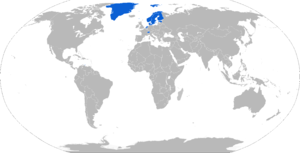
Current operators







Potential operators




Evaluation-only operators
.svg.png)


Specifications of variants (domestic)
| Strf9040 | Strf9040A | Strf9040B | Strf9040C | E/Stri90 | Lvkv90 | Bgbv90 | ||
|---|---|---|---|---|---|---|---|---|
| Total weight (tons) | 22.8 | 23.1 | 23.1 | 27.6 | 22.4 | 24 | 23.2 | |
| Length (m) | 6.47 | 6.55 | 6.55 | 7.00 | 6.55 | 6,55 | 7.9 | |
| Width (m) | 3.10 | 3.17 | 3.17 | 3.42 | 3.17 | 3.17 | 3.17 | |
| Height (m) | 2.5 | 2.71 | 2.71 | 2.75 | 2.71 | 3.45 | 2.65 | |
| Ground clearance (m) | 0.45 | 0.45 | 0.45 | 0.36 | 0.45 | 0.45 | 0.45 | |
| Crew | 3 | 3 | 3 | 3 | 3 | 7 | 4 | |
| Soldier/seats | 8 | 6–7 | 6–7 | 6–7 | 6 | - | - | |
| Main armament | Bofors 40 mm L/70B | Bofors 40 mm L/70Bc | Bofors 40 mm L/70Bc | Bofors 40 mm L/70Bc | - | Bofors 40 mm L/70Bb | - | |
| Secondary armament | 7.62 mm Ksp m/39B machine gun |
Ksp m/39C | Ksp m/39C | 7.62 mm Ksp 58 machine gun | Ksp m/39C | Ksp m/39C | Ksp m/39C | |
| Defensive equipment | Smoke dischargers 6× Galix | |||||||
| Additional equipment | Illumination mortars Lyran 2× | - | ||||||
| Gun elevation (degrees) | ? | −8 +35 | −8 +27 | −8 +27 | - | −8 +50 | - | |
| Main gun ammunition | 234 | 234 | 234 | 120 | - | 234 | - | |
| Turret weight (tons) | 3.8 | 3.9 | 3.9 | 4.9 | 3.5 | 4.9 | - | |
| Engine | Scania DSI 14 turbodiesel V8 | |||||||
| Gearbox | Allison/Perkins X-300-5 Automatic | |||||||
References
- "CV90 Armoured Combat Vehicle - Army Technology". Archived from the original on 2018-10-31.
- "CV90 CV9040 IFV infantry fighting vehicle tracked armored | Sweden Swedish army light armoured vehicles UK | Sweden Swedish army military equipment vehicles UK". Archived from the original on 2018-10-29.
- "Archived copy". Archived from the original on 2013-10-16. Retrieved 2013-10-13.CS1 maint: archived copy as title (link)
- "BAE Systems Introduces Future-Proofed CV90 - Defense Update:". Archived from the original on 2018-07-14.
- "BAE Systems CV90 MkIV new evolution of IFV armoured for modern battlefield". Army Recognition. Archived from the original on 2018-10-30.
- "Bae Systems presents the new CV90 MK4 Infantry Fighting Vehicle | IAV 2018 News Show Daily | Defence security military exhibition 2018 daily news category". Archived from the original on 2018-10-31.
- Mahon, Tim (3 June 2010). "BAE To Unveil CV90 Armadillo at Eurosatory". Defense News. Archived from the original on 21 January 2013.
- "Archived copy". Archived from the original on 2012-08-05. Retrieved 2008-11-17.CS1 maint: archived copy as title (link)
- CV9035 IFVs from Army of Netherlands to be fitted with Israeli IMI Iron Fist active protection system Archived 2016-12-28 at the Wayback Machine - Armyrecognition.com, 26 December 2016
- "Archived copy". Archived from the original on 2013-08-01. Retrieved 2014-01-15.CS1 maint: archived copy as title (link)
- "Archived copy". Archived from the original on 2010-04-10. Retrieved 2010-04-03.CS1 maint: archived copy as title (link)
- BAE Systems may upgrade CV90 armoured infantry fighting vehicle with hybrid-electric propulsion Archived 2015-09-23 at the Wayback Machine – Armyrecognition.com, 10 August 2013
- "BAE System's CV90 armor vehicle uses F1 racing suspension technology." Archived 2015-07-16 at the Wayback Machine Gizmag.com, 27 April 2015.
- Dalløkken, Per Erlien (3 September 2014). "Her er norske stormingeniørers nye framkomstmiddel". Teknisk Ukeblad (in Norwegian). Archived from the original on 17 June 2016. Retrieved 2 June 2017.
- "Finland goes for CV9030 from Patria Hägglunds Oy". BAE Systems Sweden. 2000-11-02. Archived from the original on September 28, 2007. Retrieved 2009-11-07.
- "Valmiusyhtymille nykyaikainen taisteluajoneuvo" [The readiness modern fighting vehicle] (in Finnish). The Finnish Ministry of Defence. 2000-11-02. Archived from the original on 2016-03-04. Retrieved 2009-11-07.
- "A New Order for CV90 from the Finnish Defence Forces". BAE Systems Sweden. 2004-06-30. Archived from the original on September 28, 2007. Retrieved 2009-11-07.
- Indland (in Danish), DR, 16 December 2005, archived from the original on 24 December 2014, retrieved 16 December 2005.
- Thermo-electric plates turn a tank into a car Archived 2011-09-27 at the Wayback Machine Pictures Archived 2011-09-23 at the Wayback Machine, Ing.dk 13 September 2011. Accessed: 13 September 2011.
- "Archived copy". Archived from the original on 2013-10-14. Retrieved 2013-10-13.CS1 maint: archived copy as title (link)
- Ulfhielm, Hans (1992). "Svensk stridsfordonsanskaffning 1920–1990". In Bo Kjellander (ed.). Pansartrupperna: 1942–1992 (in Swedish). Sweden: Arméns Pansarcentrum, Skövde. pp. 213–215. ISBN 91-630-1253-7.
- Cv90 Photo guide page 20 by the Swedish Armoured Historical Association ISBN 978-91-633-7880-5
- "Archived copy" (PDF). Archived from the original (PDF) on 2013-10-16. Retrieved 2013-10-13.CS1 maint: archived copy as title (link)
- "Archived copy". Archived from the original on 2013-10-15. Retrieved 2013-10-13.CS1 maint: archived copy as title (link)
- BAE Systems to deliver CV90 IFV fitted with Mjölner 120mm mortar system to Swedish army Archived 2016-12-28 at the Wayback Machine - Armyrecognition.com, 26 December 2016
- Army Guide web site: BAE Systems Hägglunds CV 90 site (direct link blocked)
- "Archived copy". Archived from the original on 2018-05-10. Retrieved 2018-05-09.CS1 maint: archived copy as title (link)
- "Eurosatory: CMI Defence and BAE Systems Hägglunds present the CV90105". Cockerill Maintenance & Ingénierie. Archived from the original on 2016-07-14. Retrieved 31 July 2015.
- "BAE systems exhibits two cv90 fighting vehicles". Army Recognition. 31 May 2017. Archived from the original on 3 June 2017. Retrieved 1 June 2017.
- Connors, Shaun (13 June 2017). "BAE Systems takes aim at Czech Army requirement with CV90". IHS Jane's 360. Archived from the original on 14 June 2017. Retrieved 14 June 2017.
- "Archived copy". Archived from the original on 2013-10-14. Retrieved 2013-10-13.CS1 maint: archived copy as title (link)
- "Archived copy". Archived from the original on 2013-10-14. Retrieved 2013-10-13.CS1 maint: archived copy as title (link)
- "Archived copy". Archived from the original on 2016-06-17. Retrieved 2017-06-02.CS1 maint: archived copy as title (link)
- "Archived copy". Archived from the original on 2018-05-10. Retrieved 2018-05-09.CS1 maint: archived copy as title (link)
- Thorén, Ola (24 January 2018). "BAE Systems introduces next evolution of Infantry Fighting Vehicle with new CV90 MkIV". BAE Systems Hägglunds. London. Archived from the original on 25 January 2018. Retrieved 25 January 2018.
- Allison, George (24 January 2018). "BAE Systems detail new CV90 MkIV variant". UK Defence Journal. Archived from the original on 25 January 2018. Retrieved 25 January 2018.
- "Vi har trent for dette lenge" (in Norwegian). Norwegian Armed Forces. 2007-11-08. Archived from the original on 2007-11-09. Retrieved 2007-11-10.
- "Norske ISAF-soldater: «Plutselig smalt det. De traff overalt» - Nyheter – Utenriks – Aftenposten.no". Archived from the original on 2008-05-30. Retrieved 2008-05-11.
- http://www.mil.no/start/aktuelt/pressemeldinger/article.jhtml?articleID=193028%5B%5D
- Archived 2010-04-12 at the Wayback Machine Nye køretøjer står stille i Helmand
- "Archived copy". Archived from the original on 2012-03-02. Retrieved 2012-03-02.CS1 maint: archived copy as title (link)
- "New export success – Denmark buys CV9035". BAE Systems. 2005-12-16. Archived from the original on 2006-10-09. Retrieved 2007-03-20.
- "Estonian Army familiarises with Dutch CV90s". IHS. 2015-02-22. Archived from the original on 2015-02-20. Retrieved 2015-03-05.
- Larrinaga, de, Nicholas (10 October 2016). "Estonia receives first CV90 IFVs". IHS Jane's 360. Retrieved 10 October 2016.
- Tomkins, Richard. "Norway selling CV90 vehicle hulls to Estonia". United Press International. Archived from the original on 13 January 2016. Retrieved 13 January 2016.
- "Netherlands completes delivery of CV90 combat vehicles to Estonia". Defence Blog. 1 April 2019. Archived from the original on 1 April 2019. Retrieved 1 April 2019.
- "Finland goes for CV9030 from Patria Hägglunds Oy". 2000-11-02. Archived from the original on 2007-09-28. Retrieved 2007-03-20.
- "A new order for CV90 from the Finnish Defence Forces". BAE Systems. 2004-06-30. Archived from the original on September 28, 2007. Retrieved 2007-03-20.
- "Major order for Land Systems Hägglunds". BAE Systems. 2004-12-10. Archived from the original on 2007-09-28. Retrieved 2007-03-20.
- Inventarisatie van bestaand defensiematerieel [Inventory of existing defense material] (in Dutch), Ministry of Defense, 7 May 2008.
- Fakta om Forsvaret [Facts about defense] (PDF) (in Norwegian), Norwegian military.
- "CV 90". Army Technology. Archived from the original on 2007-03-13. Retrieved 2007-03-20.
- "Norway Invests $750 Million Modernizing and Expanding CV90 Fleet". Defense Update. 2012-06-21. Archived from the original on 2017-10-20. Retrieved 2017-02-10.
- "Norway's improved CV90s start rolling off the production line". IHS. 2015-03-01. Archived from the original on 2015-03-05. Retrieved 2015-03-05.
- "Försvarets materielverk – Strf 90 – Stridsfordon 90" (in Swedish). Archived from the original on 2005-02-09. Retrieved 2007-03-20.
- "Försvarets materielverk – Strf 9040C – Stridsfordon 9040C" (in Swedish). Archived from the original on 2005-02-10. Retrieved 2007-03-20.
- "Delivery of final CV90 to Swedish Ministry of Defence". BAE Systems. 2002-09-24. Archived from the original on 2007-09-28. Retrieved 2007-03-20.
- "BAE Systems - IDET". BVV Trade Fairs Brno. Brno. Archived from the original on 2 June 2017. Retrieved 2 June 2017.
- "Czech Republic; Four firms shortlisted in BVP armoured vehicle tender". Defense Market Intelligence. 19 December 2018. Archived from the original on 19 December 2018. Retrieved 19 December 2018.
- Freedberg Junior, Sydney; Clark, Colin (9 October 2018). "Can BAE's CV90 Roll From European Success To US Army NGCV?". Breaking Defense. AUSA, Washington. Archived from the original on 2018-10-09. Retrieved 9 October 2018.
- "Canadian forces look at CV90 for new close combat vehicle". Ottawa Citizen. Canada communities. 2008-11-17. Archived from the original on 2009-07-11. Retrieved 2008-11-17.
- Brewster, Murray; Rennie, Steve (20 December 2013). "Military scraps plans for new light-armoured combat vehicles". The Globe & Mail. Archived from the original on 3 May 2018. Retrieved 21 December 2013.
- ISBN 978-91-633-7880-5 p. 82, Cv 90 Photo Guide – Svensk Pansarhistorisk Förening
External links
| Wikimedia Commons has media related to Hägglunds Combat Vehicle 90. |
- Combat Vehicle 90 in Army Technology (in French)
- BAE Systems Hägglunds (in Swedish)
- SoldF.com – CV9040 (in Swedish)
- Armada International 6/97-52 Information on the Norwegian IFV trials and changes found in the Norwegian CV9030 (in Norwegian)
- Danish CV9035 MkIII (in Danish)